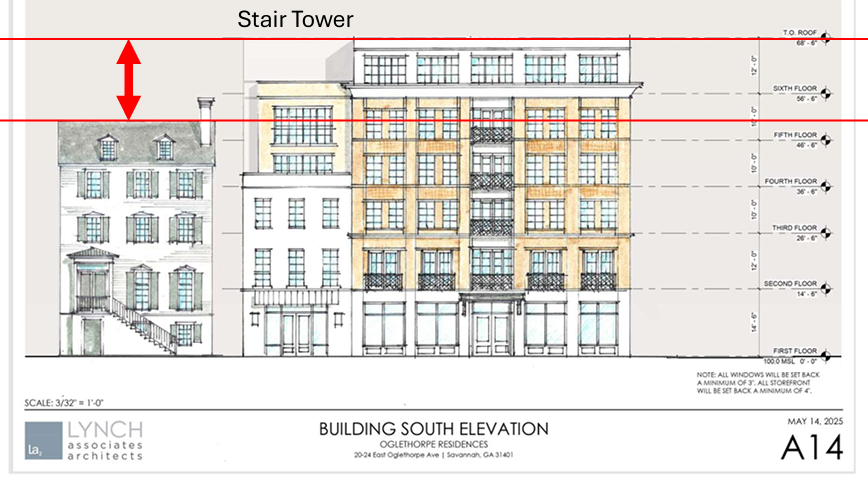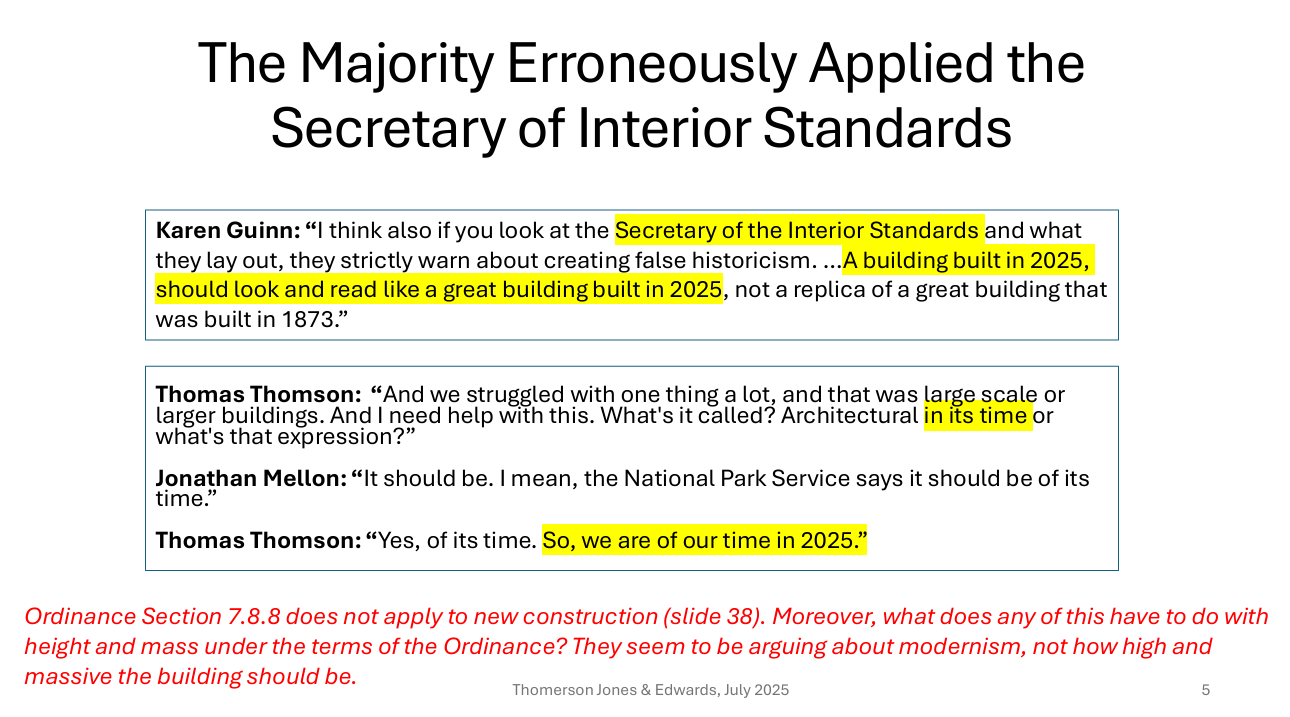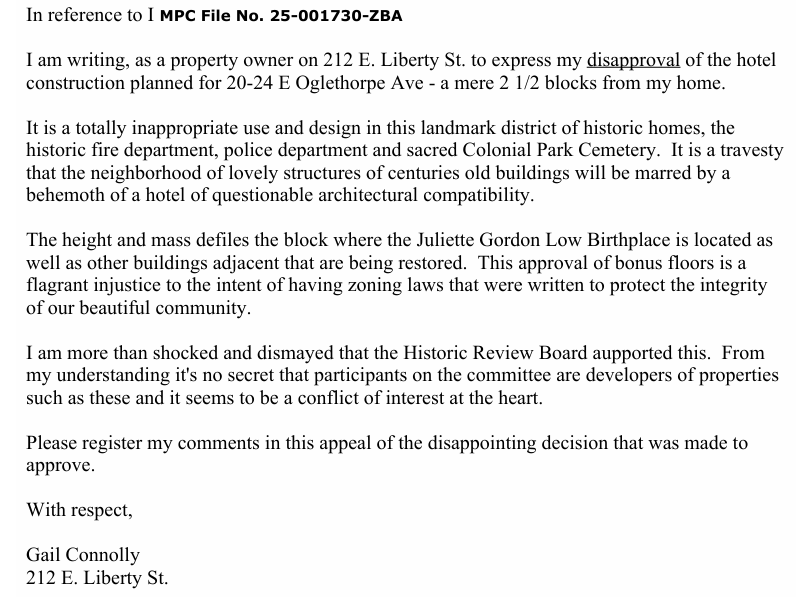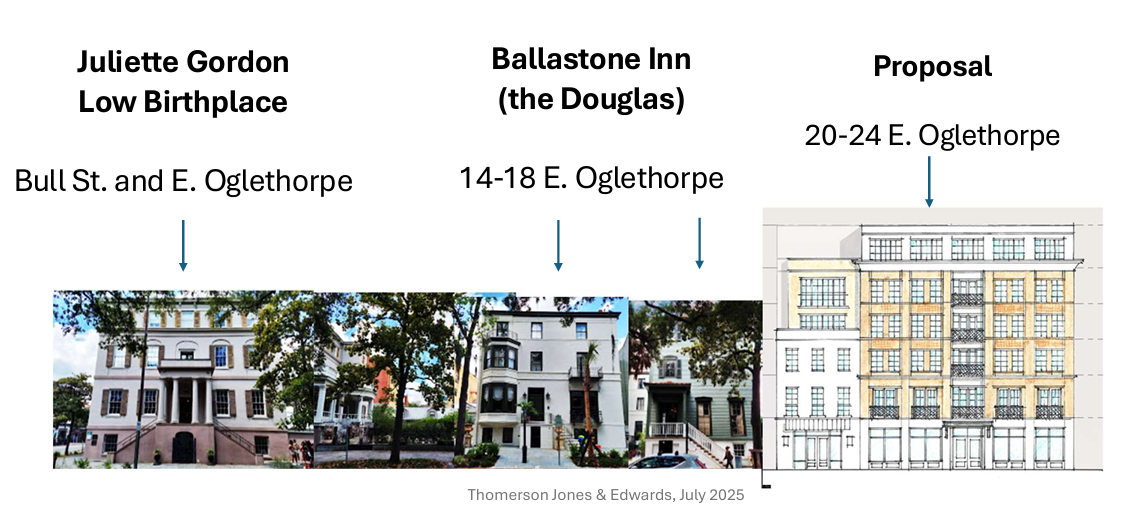FOR DECADES, the process to approve or deny new development in Savannah’s Historic District has been characterized by oversized personalities, obvious conflicts of interest, and a patchwork of regulatory boards whose innately chaotic nature always seems to miraculously straighten out whenever it’s time for them all to come together to allow a deep-pockets developer an exception to the rules.
When the exception is more the norm, that's when you know you’ve got a problem. It’s a familiar complaint of anyone advocating for preservation in Savannah.
A recent case in point is the attempt to build a new six-story mixed-use building on one of Savannah’s most charming and historic blocks.
The stretch of East Oglethorpe Avenue between Bull and Lincoln – on a thoroughfare so historic it’s named after the city’s founder – contains four of Savannah’s most iconic structures:
The Juliette Gordon Low Birthplace, a nationally renowned calling card; the antebellum gem of the Ballastone Inn; the Conrad Aiken House, childhood home of one of the South's most important poets; and the Lachlan McIntosh House – the oldest brick structure in Georgia, built in 1770 before there was even a United States.
Like any good Savannah story, this one relies on nostalgia involving a well-known local socialite – in this case, realtor Cora Bett Thomas, one of just a few people mentioned in "The Book" who is still alive, and the former owner of the parcel in question.
That corner building on Oglethorpe and Drayton, the site of Thomas’s former real estate office, is set to be demolished. While no one objects to the demolition, the controversy is over the height and mass of the building scheduled to replace it.
That building would tower over its immediate neighbor, the Ballastone Inn, and likely set a precedent for similar height variances in the very heart of Savannah’s most historic wards.

Two months ago, the Historic District Board of Review (HDBR), relying on staff work by the Metropolitan Planning Commission (MPC), narrowly upheld the right for a developer to build the new mixed-use building at the corner. The building would have retail on the ground level and condos and/or a hotel above.
Because so many regulatory bodies in Savannah depend on the same core group of MPC staff to do their legwork, there’s often a fox-guarding-the-henhouse dynamic whenever one of those bodies has their decisions called into question.
The HDBR, for example, is supposed to base its votes purely on considerations of height and mass, not usage of a building. But in this case, the HDBR said that since the use of the ground level is intended for retail and wouldn't be residential, the developer is entitled to ask for a “bonus” sixth story above the allowed five-story height.
And yes, that's what it's called: a "bonus" story. It's like a special treat!
The heart of this debate, as we reported here, has to do with the relevance of large, institutional buildings like the massive nearby Board of Education building to what new construction is allowed on a block with most all other buildings under five stories tall.
On July 24, the Savannah Zoning Board of Appeals (ZBA) heard an appeal to overturn the Historic District Board of Review’s May 14 decision.
The appeal contained many of the usual staples of any dispute over new construction in the Historic District: A forceful presentation by one of the same handful of developers’ attorneys; a litany of inconsistencies by regulatory boards; overwhelming opposition by residents who actually live nearby; and plenty of hurt feelings.
A regular voice at these types of hearings is local attorney Andrew Jones, who among other preservation-minded pursuits leads The Oglethorpe Plan Coalition, dedicated to retaining what’s left of our founder’s original town plan.
At the recent ZBA meeting, Jones not only repeated his already-stated argument against approving the new building, but directly called into question the validity of the approval vote by the HDBR.
At this hearing, Jones was technically representing Doug Godley, owner of the Ballastone Inn, who is currently renovating that historic property and rebranding it as “The Douglas.”
“The appellant [Godley] has made a major investment in this property. He has invested approximately $14 million in this project. That involved a lot of renovations, all of which went through the Historic District Board of Review,” said Jones.
“[Godley's team] followed the rules and did everything they were supposed to do. They have a right to rely on the ordinances being upheld with respect to other properties” being built nearby, he said.
In asking for the HDBR’s vote to be overturned, Jones specifically accused individual members of voting on a basis other than what the actual City ordinance says.
He deliberately appended numerous quotations from them on the record as part of his appeal.
Their votes, he said, were based “on philosophies, opinions, and wants,” rather than the written rules.
“The Secretary of the Interior standards and guidelines do not apply to new construction – that applies to contributing buildings,” Jones said in one critique. “[The HDBR] erroneously applied these standards – that is the definition of arbitrary.”

Then – in the Savannah equivalent of dropping a nuclear bomb – Jones specifically called into question the judgement of HDBR chair Karen Guinn.
Guinn, Jones said, “spoke quite extensively explaining how she would vote in this hearing… saying ‘I also want to share some of my opinions. The reasons I look at things the way I do.’ She was telling everyone she’s going to make decisions based on her opinions.”
Saying that three members of the HDBR voiced opinions “in open defiance of the ordinance” about height and mass in the Historic District, Jones mused, “I’m not sure why the HDBR is designing buildings. It’s supposed to be impartial.”
Jones continued:
“The point is to make sure you don’t have a huge building looming over a contributing building. Here there will be a building looming more than one and a half stories [over the Ballastone Inn], with a wall of blank windows facing it,” Jones said.
Jones said that another HDBR member “based his vote on the Perry Lane hotel. That’s not a contributing building, so it’s not even a justifiable comparison."
Jones referred to what he jokingly calls the fictional "Big Building Rule."
"The idea seems to be that, ‘There’s a big building over there, so I can build a big building, too.’”
Jones and numerous members of the public pointed out that despite the anomalous nature of the Board of Education building and other outsized buildings within several blocks, “the entire impression of this block is three to four stories” in height – not the six stories of the new proposed hotel.

As is so often the case in local meetings like this, overwhelming public opposition was heard by the board – and duly ignored.
“Why would anybody buy or maintain a historic building in Savannah now that all of our protections are being taken away by this new wonderful idea of putting in modern buildings with absolute disdain for the historic buildings?” asked Anna Habersham Wright.
Neighbor Chuck Moeller said:
“I came to Savannah in 1979 because of its beauty. Each time you build an ugly monstrosity like this you whittle away the beauty of the town… every time we say, ‘you can build a little higher this time,’ five years from now you can build another monstrosity a little higher than that... You can let these guys come in with their money and make more money, but we live here.”
Moeller also wondered why such out-of-scale construction wasn’t routed to areas not subject to so many historic preservation rules.
“Why don’t they put it up at Eastern Wharf, where everything else is huge?” he asked.
The owner of the Lachlan McIntosh house, Johnny Ranitz, also addressed the ZBA.
“I’m here for very selfish reasons: There’s a teardown right next to me. If this gets the six-story building, the McIntosh House will eventually have a six-story next to it, because this will set the precedent,” he said.
“I feel sorry for Mr. Godley, who will have this big old building next to him that’s going to be hideous,” Ranitz said.
In a statement, Juliette Gordon Low Birthplace Director Shannon Browning-Mullis told the ZBA that, “We do not oppose construction of a building on these lots – we want Savannah to be a vibrant city. We do oppose the height of the building suggested.”
“When a person is in Savannah, they should be able to tell where they are,” said Browning-Mullis. “It shouldn’t look like Raleigh, or Nashville, or Austin.”
The Charleston-based architect working with Godley on the Ballastone/Douglas renovation, Reg Gibson, also spoke. He had biting words for Savannah’s way of preserving its Historic District:
“Y’all have a real interesting way of doing things,” he said. “It’s very convoluted and I do not envy your job.”
Gibson urged ZBA members to “actually walk down there and stand on that corner and really look at that building, and look at the Ballastone and the BOE building, and see what everyone is talking about.”
But since this is Savannah, the debate predictably became more about personalities and wounded egos than the subject at hand.
Attorney for the developer, Harold Yellin – one of a trio of very busy (and very good) lawyers who handle almost every developer request in Savannah – chose to redirect the ZBA’s focus away from preservation and onto Jones’s criticism of HDBR members.
“This is the most insulting appeal I’ve ever seen. [Jones] has attacked MPC staff, and I take great offense at that,” Yellin said in dramatic fashion.
As any regular observer of these meetings can attest, this is ironic given that attorneys like Yellin themselves frequently call into question the judgment and ability of MPC staff and regulatory commissioners, sometimes in a scoffing tone.
In a remarkable, and very Savannah, turn of events, a few HDBR members – obviously alerted to Jones’ angle of attack – showed up to the ZBA meeting to defend their reputations.
“I don’t usually speak before you. I tend to allow you space to make your own decision,” said HDBR chair Karen Guinn.
“Quite frankly I decided to come today because I’m insulted that Mr. Jones would attack the integrity of the HDBR board and staff,” she said, referring to the “slanderous nature” of Jones’s remarks.
She assured the ZBA that the HDBR decision was “neither arbitrary or capricious.”
Jones calmly responded:
“There’s outrage from some people because I used quotes. I’m sorry, but the burden of proof is on my side, and there’s not a lot of evidence of their thinking other than what comes out of their mouths,” he said.
“I’m sorry they feel insulted. One way to not be insulted is to not make those statements,” concluded Jones.
No one familiar with these stories has any doubt about what happened next.
The ZBA closed ranks and voted unanimously to uphold the HDBR’s approval of the new six-story building. They based their decision on the narrowest possible ruling: Was there any specific reason to overturn it?
In the end, the almost brutalist nature of the state of preservation in Savannah was inadvertently summed up by MPC staffer Caitlin Chamberlain.
“There’s nothing that says they can’t be taller than historic buildings,” she said about new buildings in the Historic District.

